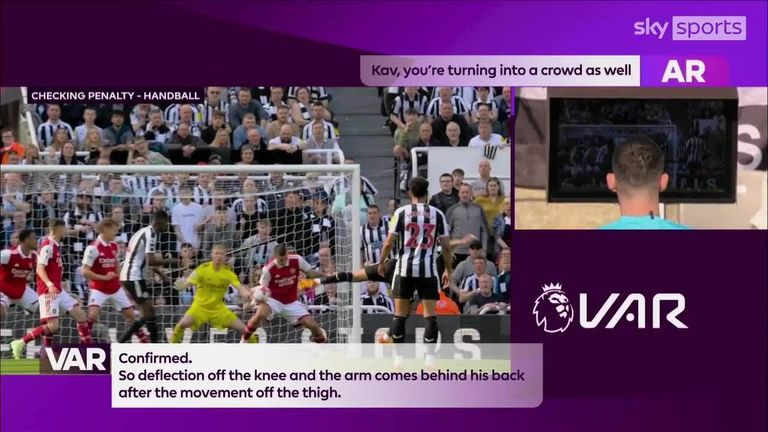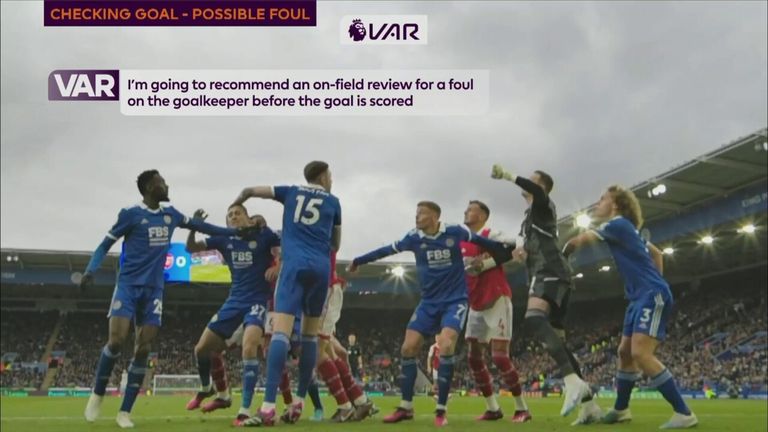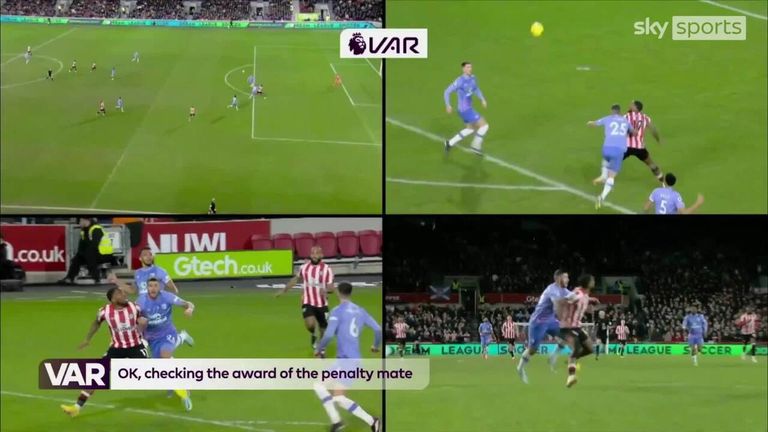[ad_1]
PGMOL chief refereeing officer Howard Webb joined Monday Night Football to explain several VAR calls throughout this season after in-game audio from key decisions was released for the first time.
Webb joined Sky Sports pundits Gary Neville and Jamie Carragher to talk viewers through selected incidents from across the 2022/23 season.
Watch the never-before-seen footage below including insight from Webb…
Havertz’s disallowed goal for handball against Liverpool
INCIDENT: Kai Havertz had a goal ruled out for handball by VAR in Chelsea’s goalless draw against Liverpool in April.
WEBB: “It’s an example of VAR working correctly. It’s an opportunity for the VAR officials to see something that the on-field officials couldn’t see. You hear Anthony Taylor say that he thinks it has hit the chest and therefore he’s going to give the goal. Sometimes the on-field officials cannot see what the ball has hit.
“The VAR can, of course, and that is an example of the video opening up the answer and the decision then being overturned.
“In this incident, it is what we call a factual review because it is based around something factual. Did the ball hit the arm or not? There’s no need to make any other interpretation on that.
“So, rather than send the referee over to the screen we make the call there and then to not waste any time and be as efficient as we can be. It’s a good use of VAR.”
Newcastle’s penalty overturned against Arsenal after Kiwior had not handballed
INCIDENT: Newcastle were awarded a penalty in their 2-0 home defeat against Arsenal after Gunners defender Jakub Kiwior appeared to block Bruno Guimaraes’ shot with his hand. But, following a VAR review, the decision was overturned after replays showed the ball deflected off Kiwior’s knee.
WEBB: “There’s two things on this one. You can clearly see the ball does strike the thigh and the shorts move. Also, the arm is moving back in towards the body. It is making the player smaller.
“The arm is not in the position the referee thought it was. He thought the arm was away from the body and therefore making himself unnaturally bigger.
“Clear and obvious in itself is a judgement. We’ve got clearly correct decisions at one end of the scale and clearly wrong ones at the other, and then there is a whole swathe of subjective ones in the middle.
“I am really keen to make our use of VAR consistent. The VARs at Stockley Park each weekend are recognising the incidents that are clear situations and the ones to get involved in, not the could be or might not be decisions because they may have different views on what might be, but they will all recognise consistently when a decision is clearly wrong.
“This again is a good use of VAR because the replays show something different to what the referee saw.”
Joelinton’s goal at West Ham given after initially being disallowed for offside
INCIDENT: Joelinton scored Newcastle’s second in their 5-1 win at West Ham after his goal was initially flagged offside but allowed following a VAR check.
WEBB: “They will be disappointed they get it wrong on the field. They are judged by the decisions they make on the field. Of course, we have VAR as a safety net, but the officials want to get the decision right on the field in real-time.
“This one looks miles offside. If you are watching in the stadium or on TV you are probably thinking the assistant referee needs to put his flag up earlier. Why delay because he’s miles off?
“We don’t want the officials to delay putting up the flag when necessary. When it’s really clear to them in their professional judgement then they stick the flag up. It avoids a clash with the goalkeeper, for example.
“But they also know that what might look clear to everyone else is really quite tight. These are specialists in their role, and they learn to delay the flag if it is close and if there is an attacking opportunity because they might have got it wrong.
“It’s not often, but they do sometimes like this example, and it is a really good one to show why we delay the flag.”
Trossard’s disallowed goal for White’s foul on Ward in Arsenal’s win at Leicester
INCIDENT: Leandro Trossard’s brilliant curling finish in Arsenal’s 1-0 win at Leicester was disallowed following a VAR review for a foul on Leicester goalkeeper Danny Ward by Ben White.
WEBB: “When we see the angle the referee could never get there’s no doubt it’s a foul by Ben White. It’s a clear foul and clear sustained holding on the goalkeeper.
“One of the things we have to evaluate as officials on the field and also as VARs is the impact of that contact. We don’t want to get too busy penalising lots of small bits of contact. It happens all over the field, particularly in crowded penalty areas.
“But when something is sustained and the judgement clearly here is that there is an impact, and I would agree. I think it is reasonable to think that the goalkeeper being held for that amount of time, needing his hands to punch the ball clear or collect the ball, is going to have an impact on him.
“So, once you see the definitive angle from behind the goal then absolutely, the VAR is right to get involved. Otherwise, a goal would be allowed to stand that has been unfairly awarded.
“Even though it wasn’t a clear error by the official, it was clear and obvious when we saw it from that angle. When you look at Ben White’s face, he thinks he might have got away with one, a sly action to hold the goalkeeper’s hand, but thankfully we’ve got the tools to step in and rectify that situation.”
Brentford awarded a penalty against Bournemouth for Senesi’s foul on Toney
INCIDENT: Brentford’s opener in their 2-0 home win over Bournemouth came after Ivan Toney was brought down inside the box by Marcos Senesi with VAR not intervening in overturning the decision.
WEBB: “The penalty that was awarded by Jarred Gillet is a credible penalty award in my opinion. I don’t think there’s any reason to think that is a clear error and that the on-field decision wouldn’t stand, and it did stand.
“We know VAR checks every penalty that is awarded and this one was checked, but we are not only checking the very final action that in this case is the penalty award.
“We are also checking the attacking possession phase, which is the phase that ultimately leads to the penalty award, which includes checking for any possible offsides or fouls.
“In this situation, we see a foul by Ivan Toney on Marcos Senesi just before he puts his arm across Toney.
“It was checked by the VAR but actually, this was an issue around process where the sequence the VAR looked at didn’t start earlier enough. It didn’t show how that contact came to happen; it was already happening when he started to look at it.
“It’s a matter of process rather than judgement.”
‘You can see VAR is working’ – Your views…
Here’s a sample of your views on what we heard from Webb on Monday Night Football…
Carl: This is a great piece on VAR and the process, and Howard Webb has given a good insight, but it still doesn’t clear up what is the rationale of going to VAR in the first place. Clear and obvious error is still a subjective statement.
United87: I always thought until tonight that VAR had the final say and told the ref to award goals etc. Watching MNF has made things more clear and you can see VAR is working.
[ad_2]





